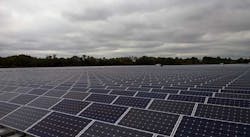The Story of Renewable Energy in the Data Center Industry
In this edition of Voices of the Industry, Kevin Hagen, of Iron Mountain, outlines the evolution of renewable energy use in the data center and colocation industry.
Kevin Hagen, Vice President Environment, Social & Governance (ESG) Strategy at Iron Mountain.
The energy footprint of the IT sector is estimated at 7 percent of global electricity consumption, According to Greenpeace International.
The data center and colocation industry is a small segment of the IT sector, but represents a large portion of the power consumption. This includes cloud services as a driving force behind the hyperscale data center. Even though the hardware for some of your applications is no longer in your data center, it is still gobbling up kilowatts in someone else’s facility.
As individuals, my bet is that few connect their own internet activity or footprint of IoT devices with power consumption. However, Google estimates that a typical search uses as much energy as illuminating a 60-watt light bulb for 17 seconds.
In the early days of the data center boom, environmentalists pointed accusing fingers at the colocation industry for its mass consumption of “dirty power”. Today and looking to the future, it is important for the industry and end users alike to realize the power and resulting environmental impact of living in a digital world.
Fortunately, the outlook is bright.
Renewable Energy – The Back Story
2007 was an interesting year.
Not only was it the year the Green Grid was founded (501(c)(6) non-profit focused on global data center efficiency), but the world was also introduced to the iPhone in June. It was as if the world of data centers began focusing on energy efficiency and sustainability just in time for what would become one of the biggest spikes in data consumption in history – rich media consumption via mobile computing. The Green Grid would bring Power Usage Effectiveness or “PUE” to the forefront of the data center manager’s dashboard, working hard to ensure that nearly every watt delivered to the facility would go to support the computer room customer requirements. As efficiency began to demand colo operator focus, green power sources would also make executive round table discussions.
Today and looking to the future, it is important for the industry and end users alike to realize the power and resulting environmental impact of living in a digital world.
Fuel cells, solar, and wind power were hot topics. However, in the end dollars and cents would rule the day, and momentum would stall as the renewable energy platform was simply not cost-efficient. At the time, colocation buyers were not willing to pay a premium to simply, “help the environment,” as their number one colocation operational cost was power, a variable that was spiking daily.
Renewable Energy – The Momentum Is Back
Fast-forward eleven years to today, and it is clear the momentum pendulum ha
Iron Mountain is part of the Renewable Energy Buyers Alliance (REBA). (Photo: Rich Miller)
s swung back in favor of renewable energy. Colocation operators putting out press releases on solar deployments, data centers powered by renewable energy, and energy efficiency audits is a regular occurrence.
What changed?
Green Became Cost Competitive
Speaking from experience, when Iron Mountain first looked into investing into our Ringer Hill Wind Farm in Pennsylvania, power costs and volatility were a primary driver for the research. After significant due diligence, it became clear that not only would the deal be cost competitive, but being able to lock in power rates over longer periods could lead to cost savings over time with spikes in power costs. We currently estimate saving (or more accurately “avoided costs”) across our entire renewable portfolio at some two million dollars a year. Of course, every situation is different, but it is fair to say that renewable energy can be cost effective.
When we took those contracts to our CFO, he said, “This is great! Can we do more?” Within the next six months, we had found more contracts using the same tools, and had achieved 100 percent of our data center services provided by renewable energy.
For the customer, there are benefits, too. Renewable energy is not only environmentally and socially responsible, it is cost effective and cost reliable.
One problem with fossil fuels is the up and down nature of costs. Renewable energy costs are stable, because there is virtually no recurring cost. Wind and sun are free. Once you build the asset, you just keep producing power. Since we know what the costs are, then renewable energy contracts can have long-term fixed pricing.
So, what is good for the environment became good for our customers and good for our business – all at the same time.
The World’s Largest Colo Buyers Demanded Green Power
Once the pricing issue was addressed, the next question to be answered was, do data center customers care about renewable power?
In the colocation industry, Equinix, Digital Realty Trust and Iron Mountain are three of the top ten “Tech and Telecom” EPA Green Power partners – a statistic we like to point out as large consumers of energy. However, do the largest colocation consumers – by direct extension power consumers – care about making the EPA list themselves?
The short answer is yes – in a big way.
Look at the top ten EPA Green Power Partner list, and you will see wholesale colocation customers like Microsoft, Google, Intel, Apple and Cisco leading the way. Earlier this year, an article was released on a large provider of streaming content that required 100 percent renewable energy as a core component for their data center RFP.
Being able to pass through the environmental attributes and zero carbon footprint of qualified renewable energy data center users who report on their carbon footprint or are members of the EPA Green Power Partner Program is a valuable deliverable and helps increase the desirability of a colo provider’s proposal.
Overcoming Complexity and Availability Challenges
In the past, green power has been difficult and complicated to procure, and you often had to have Google or Microsoft scale, brand and cash. However, as these companies found ways to make it work, they were able to publicize their processes and in collaboration with organizations such as REBA, were able to drive awareness for those looking to get involved.
Renewable energy brokers have also played a significant role in both awareness and reducing complexity when it comes to identifying the potential projects that need funding as well as how to engage in the financial backing process. Many of these brokers have active deal pipelines that buyers can use to identify renewable energy projects that fit their vision, goals, and capacity needs.
The Future of Renewable Energy – Collaboration is Key
While the EPA Top 10 have forged a path toward green energy, they can’t change the world by themselves. Collaboration has been important and is critical to next steps, especially in the data center industry. Companies like Equinix, Digital Realty and Iron Mountain have played a crucial role as data center leaders in the pursuit of renewable energy.
Here are three strategies for the colocation industry.
- Deliver on-site renewable energy sources, for example, from solar. A challenge here is meeting the growing density requirements of the colocation customer.
- Purchase renewable energy contracts with means to “deliver” the power to sites. However, energy deals can be hard to arrange, including when data centers are served by vertically integrated utility companies.
- Turn to more complicated financial transactions for example a tool called a virtual Power Purchase Agreement.
These strategies have become more mainstream for data center operators. We are not alone in our commitment to using renewable energy. Companies of all sizes are using their purchasing power to make a difference. It seems like the more companies work on renewable energy, the more they realize how important collaboration is.
[clickToTweet tweet=”Kevin Hagen – renewable energy is not only environmentally and socially responsible, it is cost effective and cost reliable. #datacenters” quote=”Kevin Hagen – renewable energy is not only environmentally and socially responsible, it is cost effective and cost reliable. #datacenters”]
Iron Mountain is part of the Renewable Energy Buyers Alliance (REBA), and I would like to encourage others to join. Led by four non-profits, including Rocky Mountain Institute, World Resources Institute, World Wildlife Fund and Business for Social Responsibility (BSR), REBA works across customers, suppliers, and policymakers to identify barriers to buying clean and renewable energy and develop solutions that meet growing demand.
For those new to the green energy space, REBA is a great place to start. Their tools offer an on-ramp to sorting out the complexities of using green energy, and getting impartial help. A good first step is to consider becoming a signatory to the Renewable energy Buyers Principals.
Another important collaboration specifically for colocation suppliers and customers is a group led by BSR called the Future of Internet Power. Made up of 13 of the biggest cloud and colocation users, this group is developing industry best practices for how companies should report about the carbon impacts of their offsite data center operations. We encourage other companies to consider signing the Corporate Colocation and Cloud Buyer’s Principles. Together, we are making a difference.
At Iron Mountain we are firm in our commitment to using renewable energy in our data center operations, and I hope you’ll join us in the pursuit of a clean, more sustainable future.
Kevin Hagen is Vice President Environment, Social & Governance (ESG) Strategy at Iron Mountain.



